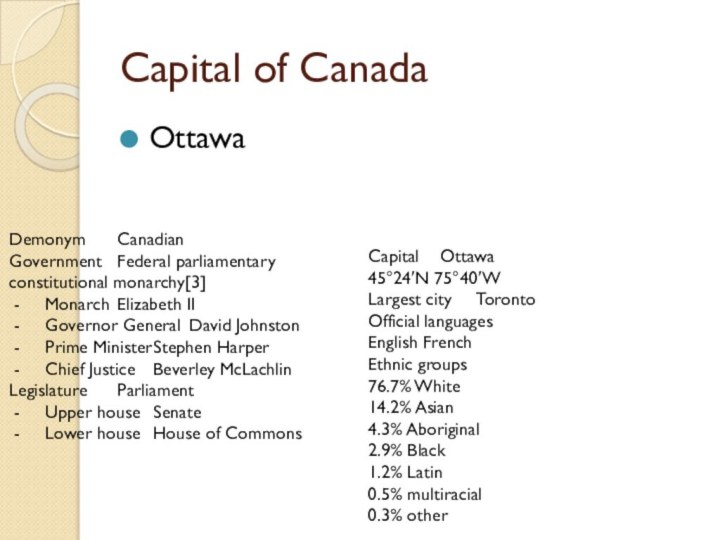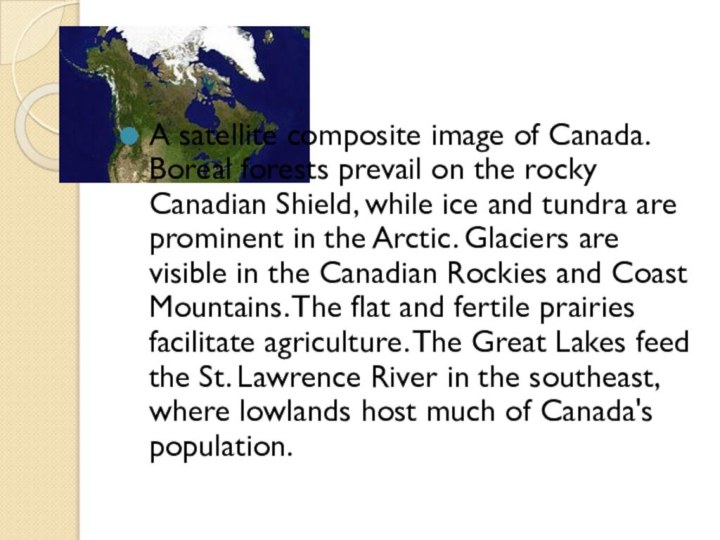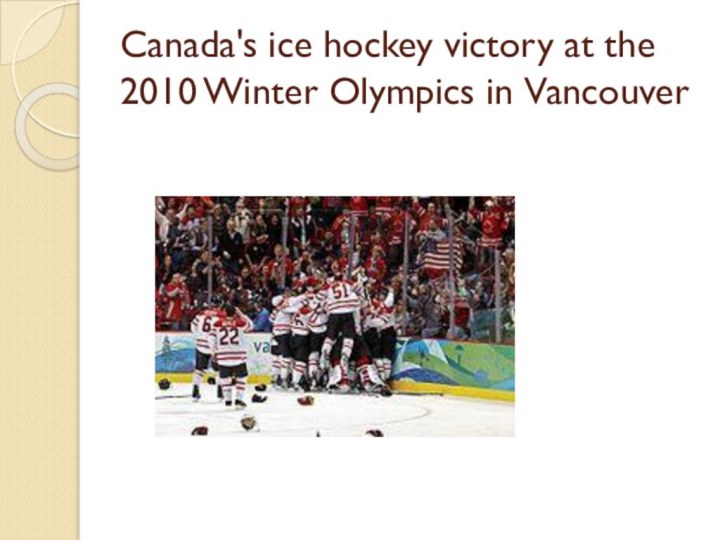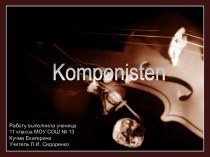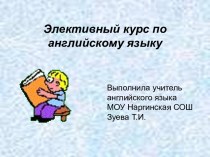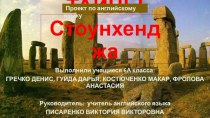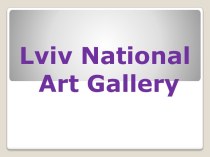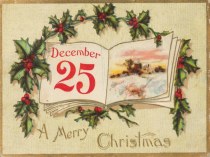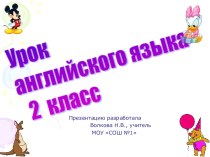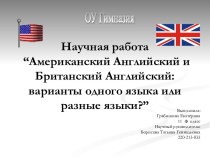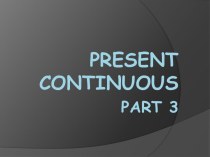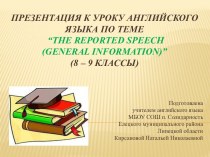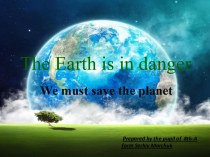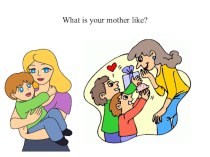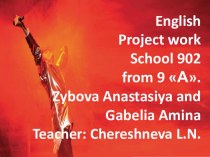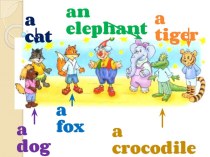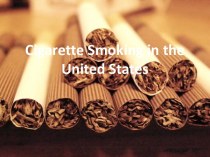Слайд 2
i/ˈkænədə/ is a country in North America consisting

of ten provinces and three territories. Located in the
northern part of the continent, it extends from the Atlantic to the Pacific and northward into the Arctic Ocean. At 9.98 million square kilometres in total, Canada is the world's second-largest country by total area and the fourth-largest country by land area. Its common border with the United States is the world's longest land border shared by the same two countries.
The land that is now Canada has been inhabited for millennia by various Aboriginal peoples. Beginning in the late 15th century, British and French colonies were established on the region's Atlantic coast. As a consequence of various conflicts, the United Kingdom gained and lost North American territories until left, in the late 18th century, with what mostly comprises Canada today. Pursuant to the British North America Act, on July 1, 1867 three colonies joined to form the autonomous federal dominion of Canada. This began an accretion of provinces and territories to the new self-governing dominion. In 1931, Britain granted Canada full independence in most matters with the Statute of Westminster 1931. The Canada Act 1982 severed the vestiges of legal dependence on the British parliament.
Слайд 3
Canada is a federal parliamentary democracy and a

constitutional monarchy, with Queen Elizabeth II as its head
of state. Canada is a member of the Commonwealth of Nations. The country is officially bilingual at the federal level. It is one of the world's most ethnically diverse and multicultural nations, the product of large-scale immigration from many countries, with a population of approximately 35 million as of December 2012. Its advanced economy is one of the largest in the world, relying chiefly upon its abundant natural resources and well-developed trade networks. Canada's long and complex relationship with the United States has had a significant impact on its economy and culture.
Canada is a developed country and one of the wealthiest in the world, with the eighth highest per capita income globally, and the eighth highest ranking in the Human Development Index. It ranks among the highest in international measurements of government transparency, civil liberties, quality of life, economic freedom, and education, and stands among the world's most educated countries- ranking first worldwide in the number of adults having tertiary education with 51% of adults having attained at least an undergraduate college or university degree (according to the OECD 2012 survey).[10] Canada's participation in economic international and intergovernmental institutions or groupings includes the G8 (Group of Eight); the Group of Ten (economic); the Group of Twenty (G-20 major economies); the North American Free Trade Agreement; and the Asia-Pacific Economic Cooperation forum. Canada's alliances include the North Atlantic Treaty Organization (NATO).
Слайд 4
Capital of Canada
Ottawa
Capital Ottawa
45°24′N 75°40′W
Largest city Toronto
Official languages
English
French
Ethnic groups
76.7% White
14.2% Asian
4.3% Aboriginal
2.9% Black
1.2% Latin
0.5% multiracial
0.3% other
Demonym Canadian
Government Federal
parliamentary
constitutional monarchy[3]
- Monarch Elizabeth II
- Governor General David Johnston
- Prime Minister Stephen Harper
- Chief Justice Beverley McLachlin
Legislature Parliament
- Upper house Senate
- Lower house House of Commons
Слайд 5
Establishment from the United Kingdom
- Constitution Act July
1, 1867
- Statute of Westminster December 11, 1931
- Canada Act April 17, 1982
Area
- Total 9,984,670 km2 (2nd)
3,854,085 sq mi
- Water (%) 8.92 (891,163 km2 / 344,080 mi2)
Population
- 2014 estimate 35,540,419[4] (37th)
- 2011 census 33,476,688[5]
- Density 3.41/km2 (228th)
8.3/sq mi
Слайд 6
A satellite composite image of Canada. Boreal forests
prevail on the rocky Canadian Shield, while ice and
tundra are prominent in the Arctic. Glaciers are visible in the Canadian Rockies and Coast Mountains. The flat and fertile prairies facilitate agriculture. The Great Lakes feed the St. Lawrence River in the southeast, where lowlands host much of Canada's population.
Слайд 8
Government and politics
Canada has a parliamentary system within
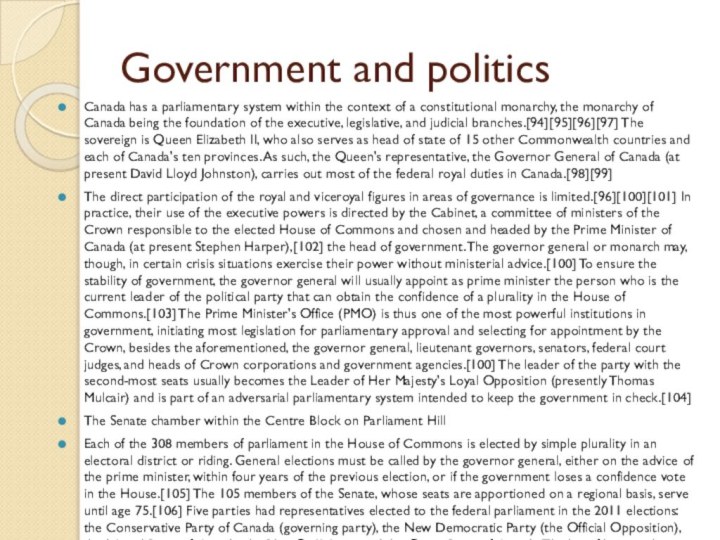
the context of a constitutional monarchy, the monarchy of
Canada being the foundation of the executive, legislative, and judicial branches.[94][95][96][97] The sovereign is Queen Elizabeth II, who also serves as head of state of 15 other Commonwealth countries and each of Canada's ten provinces. As such, the Queen's representative, the Governor General of Canada (at present David Lloyd Johnston), carries out most of the federal royal duties in Canada.[98][99]
The direct participation of the royal and viceroyal figures in areas of governance is limited.[96][100][101] In practice, their use of the executive powers is directed by the Cabinet, a committee of ministers of the Crown responsible to the elected House of Commons and chosen and headed by the Prime Minister of Canada (at present Stephen Harper),[102] the head of government. The governor general or monarch may, though, in certain crisis situations exercise their power without ministerial advice.[100] To ensure the stability of government, the governor general will usually appoint as prime minister the person who is the current leader of the political party that can obtain the confidence of a plurality in the House of Commons.[103] The Prime Minister's Office (PMO) is thus one of the most powerful institutions in government, initiating most legislation for parliamentary approval and selecting for appointment by the Crown, besides the aforementioned, the governor general, lieutenant governors, senators, federal court judges, and heads of Crown corporations and government agencies.[100] The leader of the party with the second-most seats usually becomes the Leader of Her Majesty's Loyal Opposition (presently Thomas Mulcair) and is part of an adversarial parliamentary system intended to keep the government in check.[104]
The Senate chamber within the Centre Block on Parliament Hill
Each of the 308 members of parliament in the House of Commons is elected by simple plurality in an electoral district or riding. General elections must be called by the governor general, either on the advice of the prime minister, within four years of the previous election, or if the government loses a confidence vote in the House.[105] The 105 members of the Senate, whose seats are apportioned on a regional basis, serve until age 75.[106] Five parties had representatives elected to the federal parliament in the 2011 elections: the Conservative Party of Canada (governing party), the New Democratic Party (the Official Opposition), the Liberal Party of Canada, the Bloc Québécois, and the Green Party of Canada. The list of historical parties with elected representation is substantial.
Canada's federal structure divides government responsibilities between the federal government and the ten provinces. Provincial legislatures are unicameral and operate in parliamentary fashion similar to the House of Commons.[101] Canada's three territories also have legislatures, but these are not sovereign and have fewer constitutional responsibilities than the provinces.[107] The territorial legislatures also differ structurally from their provincial counterparts.[108]
Слайд 9
Law
The Constitution of Canada is the supreme law
of the country, and consists of written text and
unwritten conventions. The Constitution Act, 1867 (known as the British North America Act prior to 1982), affirmed governance based on parliamentary precedent and divided powers between the federal and provincial governments. The Statute of Westminster 1931 granted full autonomy and the Constitution Act, 1982, ended all legislative ties to the UK, as well as adding a constitutional amending formula and the Canadian Charter of Rights and Freedoms. The Charter guarantees basic rights and freedoms that usually cannot be over-ridden by any government—though a notwithstanding clause allows the federal parliament and provincial legislatures to override certain sections of the Charter for a period of five years.[109]
Слайд 11
Culture
Canada's culture draws influences from its broad range

of constituent nationalities, and policies that promote multiculturalism are
constitutionally protected.[221] In Quebec, cultural identity is strong, and many French-speaking commentators speak of a culture of Quebec that is distinct from English Canadian culture.[222] However, as a whole, Canada is in theory a cultural mosaic – a collection of several regional, aboriginal, and ethnic subcultures.[223] Government policies such as publicly funded health care, higher taxation to redistribute wealth, the outlawing of capital punishment, strong efforts to eliminate poverty, strict gun control, and the legalization of same-sex marriage are further social indicators of Canada's political and cultural values.[224]
Historically, Canada has been influenced by British, French, and aboriginal cultures and traditions. Through their language, art and music, aboriginal peoples continue to influence the Canadian identity.[225] Many Canadians value multiculturalism and see Canada as being inherently multicultural.[67] American media and entertainment are popular, if not dominant, in English Canada; conversely, many Canadian cultural products and entertainers are successful in the United States and worldwide.[226] The preservation of a distinctly Canadian culture is supported by federal government programs, laws, and institutions such as the Canadian Broadcasting Corporation (CBC), the National Film Board of Canada (NFB), and the Canadian Radio-television and Telecommunications Commission (CRTC).[227]
Oil on canvas painting of a tree dominating its rocky landscape during a sunset.
The Jack Pine by Tom Thomson. Oil on canvas, 1916, in the collection of the National Gallery of Canada.
Canadian visual art has been dominated by figures such as Tom Thomson – the country's most famous painter – and by the Group of Seven. Thomson's career painting Canadian landscapes spanned a decade up to his death in 1917 at age 39.[228] The Group were painters with a nationalistic and idealistic focus, who first exhibited their distinctive works in May 1920. Though referred to as having seven members, five artists – Lawren Harris, A. Y. Jackson, Arthur Lismer, J. E. H. MacDonald, and Frederick Varley – were responsible for articulating the Group's ideas. They were joined briefly by Frank Johnston, and by commercial artist Franklin Carmichael. A. J. Casson became part of the Group in 1926.[229] Associated with the Group was another prominent Canadian artist, Emily Carr, known for her landscapes and portrayals of the indigenous peoples of the Pacific Northwest Coast.[230] Since the 1950s, works of Inuit art have been given as gifts to foreign dignitaries by the Canadian government.[231]
The Canadian music industry has produced internationally renowned composers, musicians and ensembles.[232] Music broadcasting in the country is regulated by the CRTC. The Canadian Academy of Recording Arts and Sciences presents Canada's music industry awards, the Juno Awards, which were first awarded in 1970.[233] Patriotic music in Canada dates back over 200 years as a distinct category from British patriotism, preceding the first legal steps to independence by over 50 years. The earliest, The Bold Canadian, was written in 1812.[234] The national anthem of Canada, "O Canada", was originally commissioned by the Lieutenant Governor of Quebec, the Honourable Théodore Robitaille, for the 1880 St. Jean-Baptiste Day ceremony, and was officially adopted in 1980.[235] Calixa Lavallée wrote the music, which was a setting of a patriotic poem composed by the poet and judge Sir Adolphe-Basile Routhier. The text was originally only in French, before it was translated to English in 1906.[236]
Слайд 12
Language
Canada's two official languages are English and French,
pursuant to Section 16 of the Canadian Charter of
Rights and Freedoms and the Federal Official Languages Act. Canada's federal government practices official bilingualism, which is applied by the Commissioner of Official Languages. English and French have equal status in federal courts, Parliament, and in all federal institutions. Citizens have the right, where there is sufficient demand, to receive federal government services in either English or French, and official-language minorities are guaranteed their own schools in all provinces and territories.[208]
Слайд 13
Sport
Hockey players and fans celebrating
Canada's ice hockey
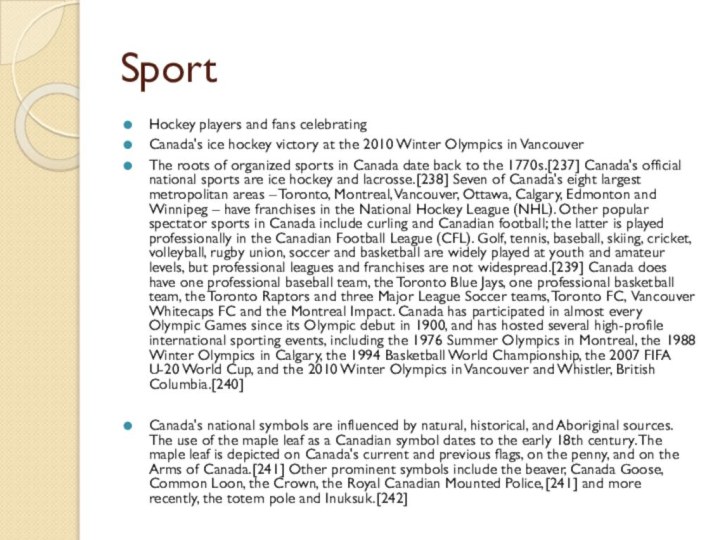
victory at the 2010 Winter Olympics in Vancouver
The roots
of organized sports in Canada date back to the 1770s.[237] Canada's official national sports are ice hockey and lacrosse.[238] Seven of Canada's eight largest metropolitan areas – Toronto, Montreal, Vancouver, Ottawa, Calgary, Edmonton and Winnipeg – have franchises in the National Hockey League (NHL). Other popular spectator sports in Canada include curling and Canadian football; the latter is played professionally in the Canadian Football League (CFL). Golf, tennis, baseball, skiing, cricket, volleyball, rugby union, soccer and basketball are widely played at youth and amateur levels, but professional leagues and franchises are not widespread.[239] Canada does have one professional baseball team, the Toronto Blue Jays, one professional basketball team, the Toronto Raptors and three Major League Soccer teams, Toronto FC, Vancouver Whitecaps FC and the Montreal Impact. Canada has participated in almost every Olympic Games since its Olympic debut in 1900, and has hosted several high-profile international sporting events, including the 1976 Summer Olympics in Montreal, the 1988 Winter Olympics in Calgary, the 1994 Basketball World Championship, the 2007 FIFA U-20 World Cup, and the 2010 Winter Olympics in Vancouver and Whistler, British Columbia.[240]
Canada's national symbols are influenced by natural, historical, and Aboriginal sources. The use of the maple leaf as a Canadian symbol dates to the early 18th century. The maple leaf is depicted on Canada's current and previous flags, on the penny, and on the Arms of Canada.[241] Other prominent symbols include the beaver, Canada Goose, Common Loon, the Crown, the Royal Canadian Mounted Police,[241] and more recently, the totem pole and Inuksuk.[242]



